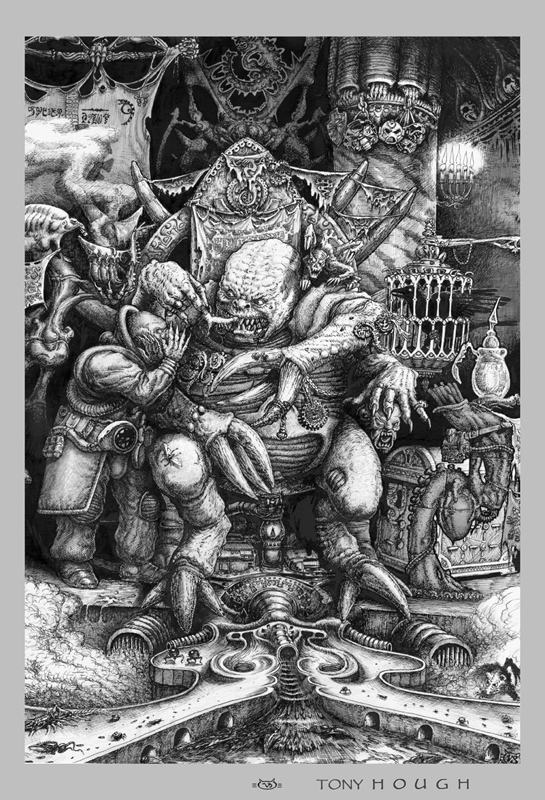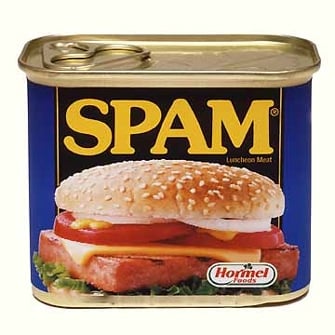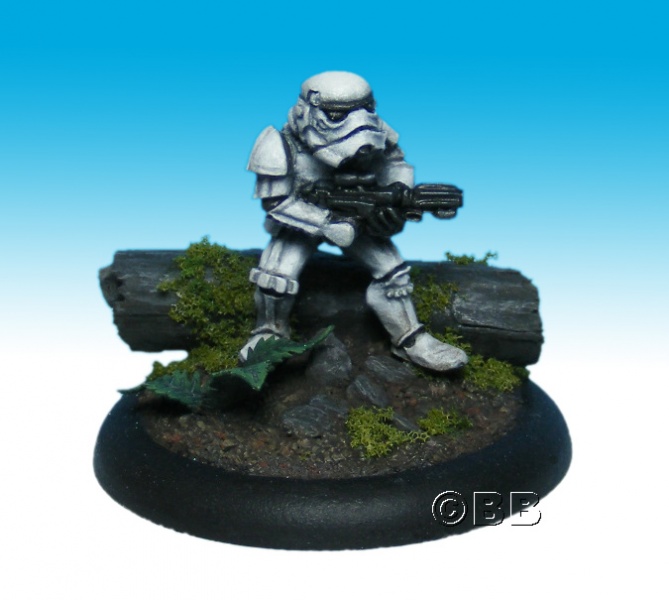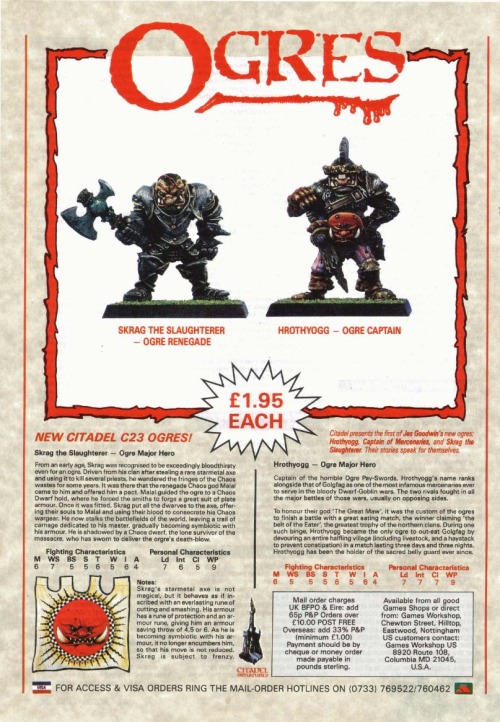A huge number of artists contributed to the look and feel of the early Warhammer, Rogue Trader and the Realm of Chaos books. Discounting the background and rules presented in these works, what you have are highly collectible art books jammed packed with astonishing, almost mind reeling, illustrations. There were a huge number of contributors during this period, and looking at the body of work they have left us, there are clear signs of creative 'cross pollination'. One style that predominates, presumably for economic as well as practical reasons, is the black and white pen and ink style. Artists such as Ian Miller and Tony Hough produced vividly detailed images whose scratchy chaos helped lay the foundations of the Warhammer Mythos.
What follows is an interview, and presentation of some of his works, with the hugely talented Tony Hough. Tony did not belong to the studio like the 'other Tony' (Ackland) and was employed as a freelance illustrator, sometimes working at frightening speed to produce a wide range of different illustrations that were used extensively in GW publications from 1987. We discuss his influences, his relationships with some of the other artists involved and some of his wider work.
RoC80s: Why an artist? What led you down the path of pencils, gouache and pen and ink?
TH: Drawing books and plasticine were cheap in the '60s! My mum had three little rugrats to deal with, so something that would keep me quietly occupied was a bonus. My early efforts were an expression of my games and daydreams, the results being less important to me than the process. Later, I started keeping and showing off my efforts both for the praise I got (mostly for being quiet) and so I could remember and elaborate on my earlier games.
RoC80s: What were your influences as a young artist?
TH: My first inspirations were the dusty corners of the house, the creepy-crawlies I found in the garden and the outside loo (yes, I'm that old...) and the stuff I saw on TV, at the Saturday Morning Pictures and in comics. So drawing and SF, Fantasy (and later Horror) were part of my life from the earliest times. I drew a lot of daleks and the robot from Lost In Space!
RoC80s: You worked on a great deal of later '80s GW products, Slaves to Darkness and Rogue Trader to name a few, how did the relationship between you and the company begin?
TH: In the early eighties I discovered Fighting Fantasy Gamebooks, RPGs and wargames and it seemed like a natural outlet for my talents, so I sent several batches of samples to GW . Then some time in '87 I had a call from John Blanche saying that he thought my style would suit a new project that was in the pipeline: Rogue Trader.
RoC80s: The Design Studio during the '80s seems to have been an incredibly creative place. Did you find it so? Which artists who also contributed to the early Warhammer/Rogue Trader mythos had the biggest influence over your work?
TH: I had some preparatory material sent to me including a lot of wonderful early 40K designs by Will Rees: Surreal, dark and very gigeresque I also later got to meet other design studio bods and artists at meetings, Games Days and conventions. It was a hugely fun, encouraging and creative team to work with.
I was especially pleased to meet a few of my existing art heroes: Jim Burns and Ian Miller were artists whose work had enthralled me for years. I also met Martin McKenna, Tony Ackland and Pete Knifton, among others, artists with whom I had a great deal in common in terms of interests and influences. Martin, in particular, was like me a massive Whovian (at a time when little Dr Who was officially available on video) and a comic art enthusiast too.
RoC80s: When we spoke at Salute, you mentioned how you were drawing Space Marines for Rogue Trader without secure knowledge about what their legs would look like, as the miniatures hadn't yet been completed. Was this a common problem during your work? Did it throw up any difficulties? If it did, how were they resolved?
TH: It was never considered a problem really as in those early stages things in the 40K universe were yet unfixed, bar the fact that the universe was a vast and varied place! There was a lot of creative room for artists to contribute to what would later crystallise into the canonical background, and anything else would simply be explained as nonstandard local variation. The same freedom would allow the gamer to import into their 40K games whatever models they could find, scratchbuild or co-opt from other ranges, which was important when there were very few "official" figures and vehicle models yet available for the game.
RoC80s: How did being a freelance artist work in relation to the studio? Did you attend meetings? Receive support materials or design briefs? How did you know what the art department wanted?
TH: I was kept informed mostly by phone or letter and sent photocopies, sample figures and photos for reference. I did go up to Nottingham a few times for special briefings, albeit rarely.
RoC80s: Slaves to Darkness is 25 years old this August. What can you recall about working on the book? Was it a chaotic and problematic as the 'legends' suggest?
TH: If the 40K universe offered a lot of creative leeway, Chaos added even more, so many of us GW artists were especially keen on this project. I didn't have any inkling of problems with that project at the time, I was just revelling in the fun of creating all those whacky Chaos creatures!
RoC80s: Did you work on design concepts for any of the miniature ranges? If so, which ones?
TH: I never directly designed any of the model ranges, which was more the job of those working at the studio itself. However at least in the early formative period the designers would often be inspired by the illustrators and vice versa.
RoC80s: What can you recall about cancelled projects? Did you contribute much artwork that was never used?
TH: I did a set of 30 fairly elaborate black and white illos for the project that would have been Battlefleet Gothic. The project was delayed for several years, although they used some material for a short-lived Space Fleet game. The rules leaflet as I recall ended up only a page long! My BG illos mostly appeared in White Dwarf, and very small too, so my intricate (and probably overblown) detail was all but lost. There were a few other illos here and there that never saw the light of day due to reshuffles and rethinks of various projects. The later version of Battlefleet Gothic came out around '97 when I was working at the Luton Games Workshop store (as a keytimer!) with an entirely new set of ship designs and artwork.
RoC80s: You are probably most well known for your 'Patriarch' image published in WD118. What is the story behind this iconic work of art?
TH: There was a lovely model of the Patriarch, his advisor and throne which I was sent photos of. I just concocted the illo from that reference, embellishing the scene with extra details, a background/setting etc. I was very pleased some time later to see that someone had recreated the illo as a diorama using the available model and scratchbuilding my bits around it, complete with caged crow and columns decorated with Terminator helmets. The illo remains a fan favourite and one of which I'm quite proud. I still have the original on my wall.
 |
| The Patriarch |
RoC80s: You produced a massive amount of black and white pen illustrations for GW... Can you give us non-artists some idea about how long many of these images took you to compose?
TH: It depended how much time I was given! Detailed work in my usual old-fashioned pen and ink style took a relatively long time: Two or three days work for an A3 page. However often there was a need to use a more concise and rapid style. For example on Warhammer Siege I had to resort to a very quick brush and ink style with soft pencil shading because I had 22 illos to complete in one week! I had an exhibition in Luton a couple of years back at which I displayed just about all of the GW originals still in my possession together for the first time...I was actually quite flabbergasted myself to see how much wall space they covered, considering my spell as a GW artist was really only about 4 and a half years in total! I have a great many artwork originals from my time working for GW which are available for sale to serious collectors. See HERE for details!
 |
| A well known Eldar image that Tony reworked ,in colour, for celebration of the 25th Anniversary of Rogue Trader. |
RoC80s: Is it true you are one of the few artists to have had work stolen from a display in Warhammer World?
TH: That's right! One of my early Eldar illos I loaned back to WW for the anniversary display was prised from a display case and had away with. Thankfully though, it was returned anonymously just a week or two later.I suppose I should feel complemented that someone coveted it so much!!
RoC80s: Where did your career take you in later days? Did you specialise in fantasy and science-fiction or did your skills find different niches to explore?
TH: Actually I've not been as successful as a freelance artist as I might have wished. I more or less stopped during the recession in the 90s, first to do a degree in Psychology and then, finding my self suddenly a parent, I was forced to resort to other "normal" jobs to support my family. Aside from the Fighting Fantasy gamebooks it has mostly been community arts projects, some children's books and some RPG supplements and private commissions for me. It was only recently, since doing Bloodbones in 2006 that I began to seriously think of getting back into illustration in any major way. I even recently did some training as a tattooist, which I enjoyed immensely and hope to continue alongside other artistic projects. Anyhow, I still think my best illustration days are ahead of me and I'm looking for new projects right now!!
 |
| One of Tony's other works of art... Disturbing stuff! |
 |
| More from the fantastic mind of Tony Hough |
And finally, many of Tony's GW pieces are for sale. See
HERE for details! Own a piece of British gaming history- if you can persuade the wife to let to spend your hard earned cash!





















